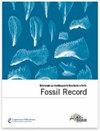Famennium-Anthozoa aus Marokko. 1. Czarnockia Różkowska, 1969 (Rugosa)
IF 2.1
4区 地球科学
Q3 Earth and Planetary Sciences
引用次数: 5
Abstract
Abstract. Aus Cephalopoda-Kalken der mittleren/oberen Clymenia-Stufe (Niveau mit Gonioclymenia) des Tafilalt im Anti-Atlas ist Czarnockia maroccana n. sp. beschrieben. Die Kollektion von 7 Polyparen zeigt eine erhebliche innerartliche Variabilitat, die nur mit ausfuhrlichen Schliffserien aller subtabularen und calicularen Regionen erfassbar wird. Das seltene, bisher allein aus der Wocklumeria-Stufe des Heiligkreuz-Gebirges in Polen bekannte Petraiidae-Genus – Endglied einer phylogenetischen Reihe Neaxon → Petraia → Famennelasma → Czarnockia – ist erstmals in einem weitern Verbreitungsareal nachgewiesen, durfte aber kosmopolitisch in der Psychrosphare (Cyathaxonia-Fazies) des Ober-Famennium anzutreffen sein. Famennian Anthozoa from Morocco. 1. Czarnockia Rozkowska, 1969 (Rugosa) The new species Czarnockia maroccana is described from cephalopod limestones of the middle/upper Clymenia genozone (level with Gonioclymenia) in the Tafilalt district of the Anti Atlas region. The small collection of seven syntypes demonstrates a surprising intraspecific variation visible only after intensive serial sectioning of all subtabular and calicular parts of the skeleton. This is the first record of the rare genus from a second area outside the type occurrence in the Wocklumeria genozone of the Polish Holy Cross Mountains. As a member of the phyletic line Neaxon → Petraia → Famennelasma → Czarnockia, the taxon should be found cosmopolitically in the psychrospheric Cyathaxonia facies of Upper Famennian times. doi: 10.1002/mmng.20020050106来自摩洛哥的Famennium anthozoa。1.Czarnockia Różkowska,1969年(鲁戈萨)
迦太基山的中一级/上的加罗尼亚顶峰(比东尼亚高峰期的加罗尼亚)可以追溯到北面Czarnockia marocana。7个色彩集显示了大量内在多样性,只有通过所有次部下和卡利尼亚地区的全面叙事可以收录这些内容。这只稀有的,到目前为止只吐出来的Wocklumeria-Stufe Heiligkreuz-Gebirges波兰(Petraiidae-Genus Endglied一套phylogenetischen Neaxon→Petraia→Famennelasma→Czarnockia是一家再次Verbreitungsareal首次证明,但国际化的Psychrosphäre (Cyathaxonia-Fazies)中可以找到Ober-Famennium的.我父母的名字是。Czarnockia Różkowska, 1969年(Rugosa)《俏妈新物种Czarnockia maroccana is described从cephalopod limestones《中东/上Clymenia genozone(级和Gonioclymenia)《Tafilalt叫做《阿特拉斯擅社交区域.(三组犯罪团体夸张注射)这是第一次来自第二次地域外的黑人和白人基因区As a中共phyletic线Neaxon→Petraia→Famennelasma→Czarnockia, the taxon should be找到cosmopolitically《psychrospheric Cyathaxonia facies of Upper Famennian时报.
本文章由计算机程序翻译,如有差异,请以英文原文为准。
求助全文
约1分钟内获得全文
求助全文
来源期刊

Fossil Record
PALEONTOLOGY-
CiteScore
2.50
自引率
7.10%
发文量
18
审稿时长
>12 weeks
期刊介绍:
Fossil Record (FR) is the palaeontological journal of the Museum für Naturkunde Berlin. This journal was founded in 1998 under the name Mitteilungen aus dem Museum für Naturkunde Berlin, Geowissenschaftliche Reihe and appears with two issues each year. Fossil Record publishes original papers in all areas of palaeontology including the taxonomy and systematics of fossil organisms, biostratigraphy, palaeoecology, and evolution. All taxonomic groups are treated, including invertebrates, microfossils, plants, and vertebrates.
 求助内容:
求助内容: 应助结果提醒方式:
应助结果提醒方式:


